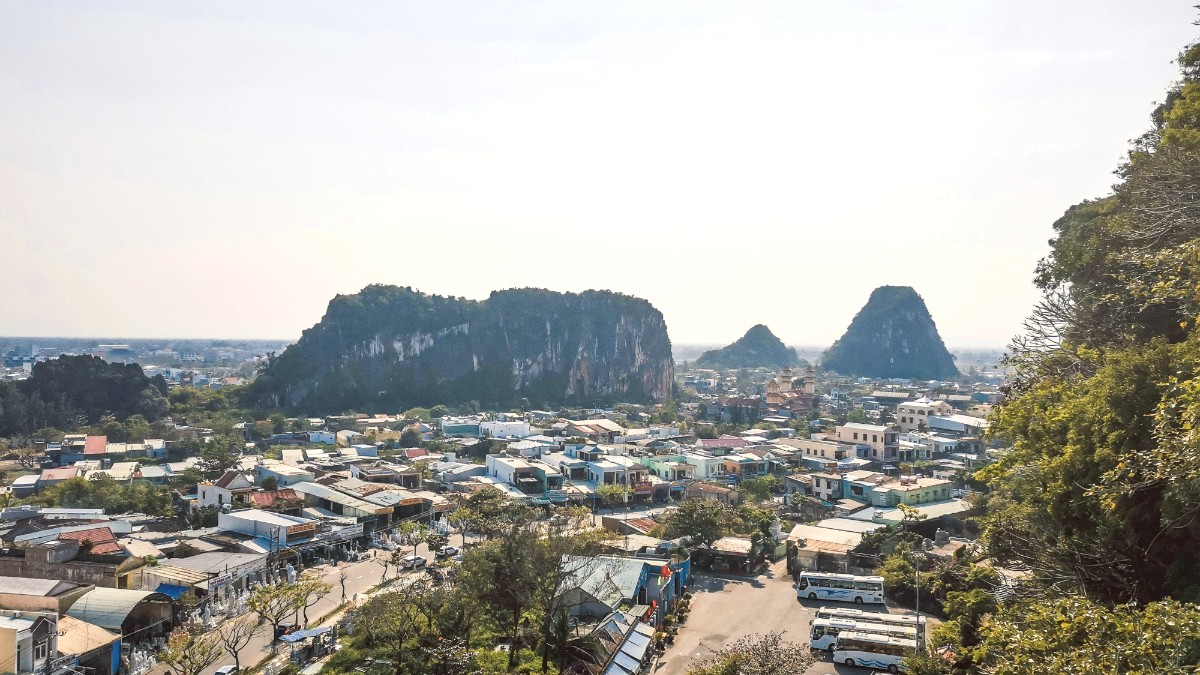
Central Vietnam, Vietnam
Central Vietnamese cuisine, including Da Nang's, has a bold balance of spicy, sour, salty, and sweet flavors. It often features fresh herbs, abundant seafood, and a strong emphasis on noodles and rice. Unlike the richer, sweeter southern cuisine or the more subtle northern cuisine, Central Vietnamese food often integrates more chili and fermented shrimp paste (mắm nêm), giving it a distinct zest.
Da Nang's coastal location brings an abundant supply of fresh seafood, which is prominent in local dishes. Expect to find fresh seafood, various rice noodles, delicate rice paper, a wide assortment of fresh greens and herbs, chili, garlic, and fish sauce (nước mắm) as staples. Fermented shrimp paste (mắm nêm), peanuts, and grilled meats or seafood also appear frequently. The flavors are typically bright and complex, often with a hint of spice.
Most Vietnamese dishes are eaten with chopsticks. A ceramic spoon is used for broth or soup.
Dishes are often shared among diners, promoting a communal eating experience. Order a variety of dishes to sample different flavors. Street food portions are generally small; this prompts you to sample various dishes without feeling overly full.
Tipping is not customary at local eateries. In mid-range to high-end restaurants, a small tip for good service is appreciated, especially if a service charge is not already included. If you share a meal with locals, anticipate "một hai ba dzô!" (one-two-three, cheers!) before drinking, often followed by "uống" (drink!).
Da Nang's signature noodle dish. Flat rice noodles with a small amount of rich, flavorful broth, often containing pork, chicken, and shrimp. Topped with fresh herbs, crushed peanuts, a hard-boiled quail egg, and crispy rice crackers.
Where to find: Quán Mì Quảng Bà Mua, Mì Quảng Ếch Bếp Trang (known for frog mì quảng).
A delicious fish cake noodle soup. It has a clear, savory broth filled with chewy fish cakes (often from mackerel or barracuda), fresh dill, and vermicelli noodles.
Where to find: Bún Chả Cá 109, Bún Chả Cá Hờn.
A crispy, savory pancake made from rice flour, turmeric, and coconut milk. Filled with shrimp, pork, and bean sprouts. Served with fresh herbs and dipping sauce.
Where to find: Bánh Xèo Bà Dưỡng.
Various sweet concoctions featuring beans, fruits, jellies, and coconut milk. A refreshing treat.
Vietnamese iced coffee with condensed milk. It is strong, sweet, and a refreshing boost.
Experience exquisite French cuisine in an opulent setting. A luxurious dining experience is found here.
These establishments blend quality and value, often with inviting ambiances.
Explore the city's street food scene for affordable and authentic flavors.
These are must-visit locations for experiencing local food culture. These markets offer fresh produce, prepared meals, and an energetic atmosphere.
Street Food Alley (K23/14 Trần Kế Xương) is another hub for Da Nang specialties.
You will find an abundant choice of international cuisine, especially in the An Thuong area and around My Khe Beach. This includes Korean, Japanese, Indian, Italian, and various Western restaurants.
Diversity in dining from around the globe is available.
Look for "Quán Chay" (vegetarian restaurants).
Limited but growing options, especially in An Thuong.
Can be challenging; inquire about ingredients carefully.
Carry translated allergen cards for clear communication.
This can be challenging due to wheat-based noodles and soy sauce. Rice and rice noodles are common, but cross-contamination risks exist. Learn basic Vietnamese phrases for "no soy sauce" (không nước tương) or "no wheat" (không lúa mì).
Clear communication is .
Nuts, especially peanuts, are common in many dishes. Seafood allergies pose a challenge in a coastal city. It is advisable to carry translated allergen cards explaining your specific dietary restrictions to restaurant staff.
Patience and clear communication are important.
Use apps like HappyCow for finding vegetarian and vegan options. Communicate clearly and patiently with restaurant staff. Translation apps or written notes can be used when needed.
In busy street food settings, cross-contamination is a possibility. If you have severe allergies, consider dining at establishments that can explicitly confirm allergen-free preparation methods.
Street food represents the heart of Vietnamese cuisine. Seek out bustling stalls with high local turnover, which indicates freshness and popularity.
Beyond coffee, try fresh sugarcane juice (Nước Mía), various fruit smoothies (Sinh Tố), and local beers like Bia Larue. These quench thirst and offer local flavors.
Simple phrases like "Cảm ơn" (thank you), "Ngon quá!" (delicious!), and asking about ingredients (e.g., "Không thịt?" - no meat?) can enhance your dining experience and aid communication.
Learn to prepare traditional Vietnamese dishes like pho or spring rolls. Many classes start with a market visit to select fresh ingredients.
A hands-on way to understand local cuisine.
Explore street food and local specialties with a knowledgeable guide. These tours share insights into culinary traditions and hidden eateries.
A good introduction to Da Nang's food scene.
Numerous large seafood restaurants line the beach road (Vo Nguyen Giap Street). Pick live seafood from tanks and have it cooked to order in various styles. This is a fresh and interactive dining experience.
Restaurants along the Han River have scenic views, especially at night when the city's bridges are illuminated. Enjoy a meal with the city lights reflecting on the water.
Don't shy away from small, unassuming local eateries. These often serve the most authentic and delicious versions of traditional dishes at very affordable prices. Look for places with many locals.
Always check for fresh ingredients, especially with seafood. A good indicator is a high turnover of customers.